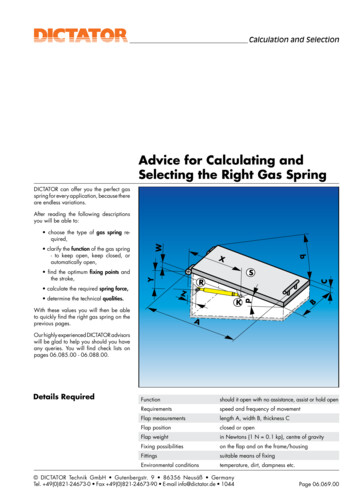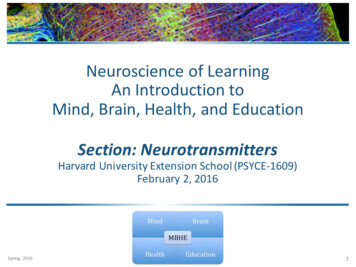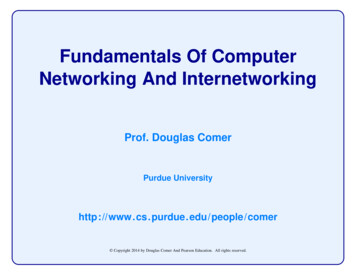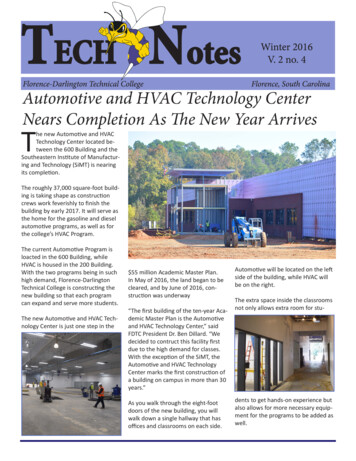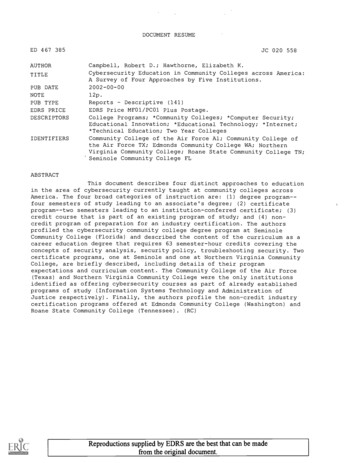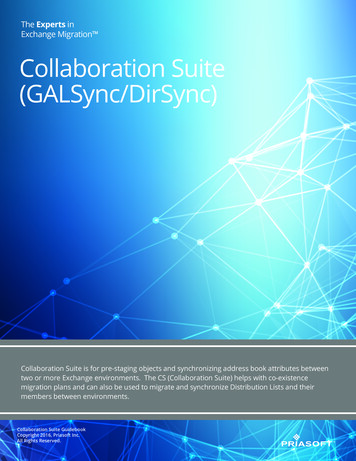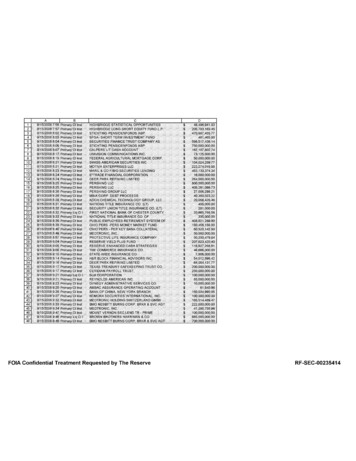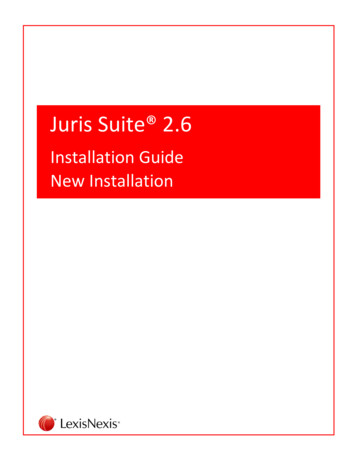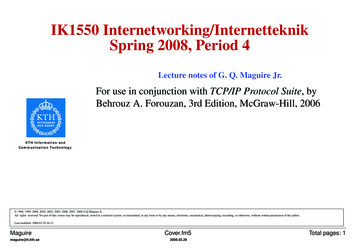
Transcription
IK1550 Internetworking/InternetteknikSpring 2008, Period 4Lecture notes of G. Q. Maguire Jr.For use in conjunction with TCP/IP Protocol Suite, byBehrouz A. Forouzan, 3rd Edition, McGraw-Hill, 2006KTH Information andCommunication Technology 1998, 1999, 2000, 2002, 2003, 2005, 2006, 2007, 2008 G.Q.Maguire Jr. .All rights reserved. No part of this course may be reproduced, stored in a retrieval system, or transmitted, in any form or by any means, electronic, mechanical, photocopying, recording, or otherwise, without written permission of the author.Last modified: 008.03.29Total pages: 1
IK1550 Internetworking/InternetteknikSpring 2008, Period 4Module 1: IntroductionLecture notes of G. Q. Maguire Jr.For use in conjunction with TCP/IP Protocol Suite, byBehrouz A. Forouzan, 3rd Edition, McGraw-Hill, 2006.KTH Information andCommunication TechnologyFor this lecture: Chapters 1-5 1998, 1999, 2000, 2002, 2003, 2005, 2006, 2007, 2008 G.Q.Maguire Jr. .All rights reserved. No part of this course may be reproduced, stored in a retrieval system, or transmitted, in any form or by any means, electronic, mechanical, photocopying, recording, or otherwise, without written permission of the author.Last modified: on.fm52008.03.29Total pages: 101
Welcome to the Internetworking course!The course should be fun.We will dig deeper into the TCP/IP protocols and protocols built upon them.Information about the course is available from the course web page:http://www.it.kth.se/courses/IK1550/The best is to always look at the link from http://web.it.kth.se/ maguireMaguiremaguire@it.kth.seWelcome to the Internetworking course!2008.03.29Introduction 3 of 101Internetworking/Internetteknik
Staff Associated with the CourseInstructor (Kursansvarig)prof. Gerald Q. Maguire Jr. maguire at kth.se Assistants for Recitation Sessions (Övningar)noneAdministrative Assistant: recording of grades, registration, etc.Irina Radulescu irina.radulescu at wireless.kth.se Maguiremaguire@it.kth.seStaff Associated with the Course2008.03.29Introduction 4 of 101Internetworking/Internetteknik
Goals, Scope and MethodGoals of the Course To give deep knowledge and competence (designing, analyzing, anddeveloping) of Internet protocols and architecture, both practical andanalytical. To be able to read and understand the Internet standardizationdocuments (IETF RFCs and Internet Drafts) and current Internetliterature. You should have the knowledge and competence to do exciting Internetrelated research and development.Scope and Method Dig deeper into the TCP/IP protocol suite by using diagnostic tools toexamine, observe, and analyze these protocols in action.Understanding the details! Demonstrate this by writing a written report.Maguiremaguire@it.kth.seGoals, Scope and Method2008.03.29Introduction 5 of 101Internetworking/Internetteknik
AimThis course will give both practical and general knowledge on the protocols thatare the basis of the Internet. After this course you should have a good knowledgeabout Internet protocols and internetworking architecture. You should have ageneral knowledge aiding you in reading research and standardization documentsin the tion 6 of 101Internetworking/Internetteknik
Learning OutcomesFollowing this course a student should be able to: Understand the principles on which internetworking is based - whichdefine the Internet (both what it is and why it has proven to be sosuccesful) Understand TCP/IP protocol stack, layering, encapsulation andmultiplexing Understand multiplexing, demultiplexing, upward and downward multiplexing Encapsulation as used for Mobile IP, Virtual Private Networks (VPNs), IP security, . andother tunnelling protocols Understand how information is encoded in headers and how the choice of this encodingand field size may effect the use and evolution of a protocol Understand how data is encoded in the body of a packet and how this may effectinternetworking - especially in the presence of firewall and network address translators. Understand IP Addressing, subnetting and address resolution including the interaction of protocols across layers Understand a number of higher layer protocols including the securityrisks and performance limitations of eachMaguiremaguire@it.kth.seLearning Outcomes2008.03.29Introduction 7 of 101Internetworking/Internetteknik
Understand the basic details of routing and routing protocols (RIP, BGP,OSPF) - with an emphasis on their limitations and behaviors Understand autoconfiguration and naming (BOOTP, DHCP, DNS,DDNS, DNSsec, ENUM, . ) - with an emphasis on risks, limitations,scaling, and evolution Understand the nature and pressures on the design and operations ofinternets - particularily on scaling, performance, delay bounds, due tonew Internet applications (VoIP, streaming, games, peer-to-peer, etc. Understand the advantages and disadvantages of IPv6 (in comparisonto IPv4) Read the current literature at the level of conference papers in thisarea. While you may not be able to understand all of the papers in journals, magazines, andconferences in this area - you should be able to read 90% or more of them and have goodcomprehension. In this area it is especially important that develop a habit of reading thejournals, trade papers, etc. In addition, you should also be aware of both standardizationactivities, new products/services, and public policy in the area. Demonstrate knowledge of this area in writing. By writing a paper suitable for submission to a trade paper or national conference in thearea.Maguiremaguire@it.kth.seLearning Outcomes2008.03.29Introduction 8 of 101Internetworking/Internetteknik
Prerequisites Datorkommunikation och datornät/Data and computer communicationor Equivalent knowledge in Computer Communications (this requirespermission of the 08.03.29Introduction 9 of 101Internetworking/Internetteknik
ContentsThis course will focus on the protocols that are the fundaments of the Internet. Wewill explore what internetworking means and what it requires. We will give bothpractical and more general knowledge concerning the Internet networkarchitecture.The course consists of 14 hours of lectures (combined with 14 hours of recitations(övningar)), and 40-100 hours of written .29Introduction 10 of 101Internetworking/Internetteknik
Topics What an internet is and what is required of protocols to allowinternetworking details of routing and routing protocols (RIP, BGP, OSPF, ) multicasting Domain Name System (DNS, Dynamic DNS) what happens from the time a machine boots until the applications arerunning (RARP, BOOTP, DHCP, TFTP) details of the TCP protocols and some performance issues details of a number of application protocols (especially with respect todistributed file systems) network security (including firewalls, AAA, IPSec, SOCKs, ) differences between IPv6 and IPv4 network management (SNMP) and We will also examine some emerging topics: cut-through routing, tag switching, flow switching, QoS, Mobile IP, Voice over IP, SIP, NAT,VPN, Diffserv, .MaguireTopicsIntroduction 11 of rnetteknik
Examination requirements Written assignment (6 ECTS credits) based on lectures, recitations, and your referencesMaguiremaguire@it.kth.seExamination requirements2008.03.29Introduction 12 of 101Internetworking/Internetteknik
Grades: A.F (ECTS grades) To get an "A" you need to write an outstanding or excellent paper. To get a "B" you need to write a very good paper, i.e., it should be eithera very good review or present a new idea. To get a "C" you need to write a paper which shows that youunderstand the basic ideas underlying internetworking and that youunderstand one (or more) particular aspects at the level of an averageundergraduate student in the area. To get a "D" you need to demonstrate that you understand the basicideas underlying internetworking, however, your depth of knowledge isshallow in the topic of your paper. If your paper has some errors (including incomplete references) thegrade will be an "E". If your paper has serious errors the grade will be an "F".If your paper is close to passing, but not at the passing level, then you will be offered the opportunity for "komplettering",i.e., students whose written paper does not pass can submit a revised version of their paper (or a completely new paper) which will be evaluated.Maguiremaguire@it.kth.seGrades: A.F (ECTS grades)2008.03.29Introduction 13 of 101Internetworking/Internetteknik
Ethics, Rights, and ResponsibilitiesThere is a policy of zero tolerance for cheating, plagiarism, etc. - for details seehttp://www.kth.se/dokument/student/student rights.pdfSee also the KTH Ethics Policies Maguiremaguire@it.kth.seEthics, Rights, and Responsibilities2008.03.29Introduction 14 of 101Internetworking/Internetteknik
Written AssignmentGoal: to gain analytical or practical experience and to show that you havemastered some Internetworking knowledge. Can be done in a group of 1 to 3 students (formed by yourself). Eachstudent must contribute to the final report. There will be one or more suggested topics, additional topics arepossible (discuss this with one of the teachers before starting).Maguiremaguire@it.kth.seWritten Assignment2008.03.29Introduction 15 of 101Internetworking/Internetteknik
Assignment Registration and Report Registration: Friday 02-May-08, to maguire@kth.se "Subject: IK1550 topics" Group members, leader. Topic selected. Final report The report should clearly describe: 1) what you have done; 2) if you have done someimplementation and measurements you should describe the methods and tools used, alongwith the test or implementation results, and your analysis. The length of the final report should be 7-8 pages for each student (detailed measurements,configuration scripts, etc. can be in additional pages as an appendix or appendices). 1 Contribution by each member of the group - must be clearFinal Report: written report due before Monday 26-May-08 at 23:59 Send email with URL link to a PDF file to maguire@kth.se Late assignments will not be accepted (i.e., there is no guarantee thatthey will graded in time for the end of the term)Note that it is pemissible to start working well in advance of the deadlines!1. Papers which are longer than 8 pages per student will have a maximum grade of "E".Maguiremaguire@it.kth.seAssignment Registration and Report2008.03.29Introduction 16 of 101Internetworking/Internetteknik
LiteratureThe course will mainly be based on the book: Behrouz A. Forouzan, TCP/IPProtocol Suite, 3rd edition, McGraw-Hill, publication date January 2005,(Copyright 2006) 896 pages, ISBN 0072967722 (hardbound) or 0071115838(softbound)Other additional references include: TCP/IP Illustrated, Volume 1: The Protocols by W. Richard Stevens, Addison-Wesley,1994, ISBN 0-201-63346-9 and Internetworking with TCP/IP:Principles, Protocols, and Architectures, Vol. 1, by Douglas E. Comer,Prentice Hall, 4th edt. 2000, ISBN 0-13-018380-6. the commented source code in TCP/IP Illustrated, Volume 2: The Implementationby Gary R. Wright and W. Richard Stevens, Addison-Wesley, 1995,ISBN 0-201-63354-X IPv6: The New Internet Protocol, by Christian Huitema, Prentice-Hall,1996, ISBN 08.03.29Introduction 17 of 101Internetworking/Internetteknik
concerning HTTP we will refer to TCP/IP Illustrated, Volume 3: TCP forTransactions, HTTP, NNTP, and the UNIX Domain Protocols, Addison-Wesley, 1996, ISBN0-201-63495-3.With regard to Mobile IP the following two books are useful as additional sources: Mobile IP: Design Principles and Practices by Charles E. Perkins,Addison-Wesley, 1998, ISDN 0-201-63469-4. Mobile IP: the Internet Unplugged by James D. Solomon, Prentice Hall,1998, ISBN 0-13-856246-6.Internetworking Technologies Handbook by Kevin Downes (Editor), H. Kim Lew,Steve Spanier, Tim Stevenson /cisintwk/ito doc/index.htm)We will refer to other books, articles, and RFCs as necessary. In addition, therewill be compulsory written 3.29Introduction 18 of 101Internetworking/Internetteknik
Lecture PlanSubject to revision! Lecture 1: Introduction and IP basics Lecture 2: IP and ICMP Lecture 3: User Datagram Protocol (UDP) & TCP Lecture 4: TCP and SCTP Lecture 5: Dynamic Routing Lecture 6: IP Multicast and Mobile IP Lecture 7: Internet Security, VPNs, Firewalls, and NATFuture Issues and SummaryMaguiremaguire@it.kth.seLecture Plan2008.03.29Introduction 19 of 101Internetworking/Internetteknik
Context of the course“The network called the Internet is the single most importantdevelopment in the communications industry since the publicswitched voice network was constructed ”-- John Sidgmorewhen he was CEO, UUNET Technologiesand COO, WorldCom11. ent/slide2.html {this URL no longer functions}Maguiremaguire@it.kth.seContext of the course2008.03.29Introduction 20 of 101Internetworking/Internetteknik
Network ArchitectureWLANFDDIMHAPR HHRswitch RRWANswitchEthernet LANsToken RingswitchswitchRIWUMSCBSCHLR/VLR BTS MHRMHAd hocPANMHCellular networksMHFigure 1: Multiple network technologies - internetworked togetherNote that some of the routers act as gateways between different types of networks.Maguiremaguire@it.kth.seNetwork Architecture2008.03.29Introduction 21 of 101Internetworking/Internetteknik
Power of the Internet (chaos)‘“Historically, the Internet has been an environment in which toexperiment. There have been a few basic rules. The most importantis the standard for IP and TCP.The are other important standards for promulgating routinginformation and the like, but the real power of the Internet idea is thatthere are not mandidated stanards for what can run over the ‘Net.Anyone who adheres to TCP/IP standards can create applicationsand run them without getting anyone’s permission. No ISP even hasto know you are experimenting (or playing, which is also OK). Thisfreedom produces unpredictable results. New industries can becreated almost overnight and existing industries severely affected. ”-- Scott O. Bradner, “The Importance of Being a Dynamist”,Network World, December 13, 1999, p. 48 (www.nwfusion.com)Maguiremaguire@it.kth.sePower of the Internet (chaos)2008.03.29Introduction 22 of 101Internetworking/Internetteknik
Internet Trends Numbers of users and internet devices increases very rapidly Network Wizards’ Internet Domain Survey - http://www.isc.org/index.pl?/ops/ds/– Jan. 2007: 433,193,199, Jan.2006: 394,991,609, Jan. 2005: 317,646,084 hosts RIPE’s survey European hosts :– Estimates are based on DNS information; http://www.ripe.net/hostcount/hostcount / Network Weather Maps - c,busy QoS: Demand for integrating many different types of traffic, such asvideo, audio, and data traffic, into one network Multicast, IPv6,RSVP, DiffServ, emphasis on high performance, and TCPextensions (we will examine a number of these in this course) Mobility: both users and devices are mobile There is a difference between portable (bärbar) vs. mobile (mobil). IP is used in wireless systems (for example 3G cellular). Increasing use of wireless in the last hop (WLAN, PAN, Wireless MAN, ) Security: Wireless mobile Internet - initial concern driven by wireless link Fixed Internet - distributed denial of service attacks, increasing telecommuting, Maguiremaguire@it.kth.seInternet Trends2008.03.29Introduction 23 of 101Internetworking/Internetteknik
IP traffic growing exponentially!Traffic increasing (but not due to voice) IPtraffic between US and Sweden many times the total voice FAX traffic many Gbit/s transatlantic fiberFixed Links - arbitrarily fast: LANs:10Mbits/s, 100Mbits/s, 1Gbits/s, 10Gbits/s, Backbones: Gigabits/sTransoceanic fibers between continents Gbit/s Tbit/s Major sites link to backbones: increasingly 10 Mbit/s to Gbit/s Individual users links: 28.8 Kbits/s and ISDN (128Kbits/s) ethernet and xDSL (2 Mbits/s . 100 Mbits/s)Points of Presence (PoPs) FIX/CIX/GIX/MAE1 GigaPoPs(George) Guilder’s Law states that network speeds will triple every year for the next 25 years.This dwarfs Moore’s law that predicts CPU processor speed will double every 18 months.1. Federal Internet eXchange (FIX), Commercial Internet eXchange (CIX), Global Internet eXchange (GIX), Metropolitan Access Exchange (MAE)Maguiremaguire@it.kth.seIP traffic growing exponentially!2008.03.29Introduction 24 of 101Internetworking/Internetteknik
Speed“. The Internet world moves fast. The integration of voice and data onto a single network isnot being lead by the International Telecommunications Union or by Bellcore. Rather, itsbeing lead by entrepreneurs like . Until now, the voice networks dominated. Data couldride on top of the phone network -- when it was convenient. The explosion of data networkingand Internet telephony technology is making the opposite true. Now voice can ride on datanetworks -- when it is convenient.”1Because of bandwidth constraints, Internet telephony would not be amajor factor “for a long time -- maybe nine to twelve months.”-- president of a major ISP2Internet time - 7x real time-- Ira Goldstein, HP1. from http://www.dialogic.com/solution/internet/apps.htm {no longer a valid URL}2. from http://www.dialogic.com/solution/internet/apps.htm {no longer a valid URL}MaguireSpeedIntroduction 25 of rnetteknik
Growth ratesSome people think the Internet bandwidth explosion is relatively recent, but right from thebeginning it’s been a race against an ever-expanding load. It isn’t something you can planfor. In fact, the notion of long-range planning like the telcos do is almost comical. Just lastmonth, a local carrier asked us why we didn’t do five-year plans, and we said, “We do-aboutonce a month!”-- Mike O’Dell1 VP and Chief Technologist UUNETMike points out that the growth rate of the Internet is driven by the increasingspeed of computers, while telcos have traffic which was proportional to the growthin numbers of people (each of whom could only use a very small amount ofbandwidth). by 1997 UUNET was adding at least one T3/day to their backbone1. from http://www.data.com/25years/mike odell.html {no longer a valid URL}Maguiremaguire@it.kth.seGrowth rates2008.03.29Introduction 26 of 101Internetworking/Internetteknik
¿Question?“Which would you rather have twice as fast:your computer’s processor or modem?After 30 years of semiconductor doublings under Moore’s Law,processor speed are measured in megahertz. On the other hand,after 60 years of telco’s snoozing under monopoly law, modemspeeds are measure in kilobits. Modems are way too slow for Internetaccess, but you knew that.”1-- Bob Metcalfe, inventor of Ethernet in 19731. “From the Ether: Moving intelligence and Java Packets into the Net will conserve bandwidth”, by Bob Metcalfe, Inforworld, Oct., 6, 1997, pg. ntroduction 27 of 101Internetworking/Internetteknik
Increasing Data Rates“Ethernet’ 3 Mbps Ethernet (actually 2.944 Mbits/sec)10 Mbps Ethernet (which became IEEE 802.3)100 Mbps Ethernet (100Tx)Gigabit Ethernet (IEEE 802.3z, IEEE 802.3ab)10 GbE (IEEE 802.3ae), 40GbE, and 100GbEOptical Dense Wavelength Division Multiplexing (DWDM) - allowing 1000s ofmulti-Gbits/s channels to be carried on existing fibersWireless IEEE 802.11 Wireless LAN (2 . 100 Mbits/s) IEEE 802.15 Wireless Personal Area Network (WPAN) IEEE 802.16 Metropolitan Area Networks - Fixed Broadband WirelessThe "Get IEEE 802 " program makes these standards available .htmlMaguiremaguire@it.kth.seIncreasing Data Rates2008.03.29Introduction 28 of 101Internetworking/Internetteknik
InternetworkingInternetworking is based on the interconnection (concatenation) of multiple networks accommodates multiple underlying hardware technologies by providinga way to interconnect heterogeneous networks and makes theminter-operate.We will concern ourselves with one of the most common internetworkingprotocols IP (there are other internetworking protocols, such as Novell’sInternetwork Packet Exchange (IPX), Xerox Network Systems (XNS), IBM’sSystems Network Architecture (SNA), OSI’s ISO-IP).We will examine both IP: version 4 - which is in wide use version 6 - which is coming into useInternet: the worldwide 8.03.29Introduction 29 of 101Internetworking/Internetteknik
The Internet TodayLocal LocalLocal LocalLocal ISPRegionalISP ionalISPkey: Internet Serice Provider (ISP), Network Access Point (NAP)Maguiremaguire@it.kth.seThe Internet Today2008.03.29Introduction 30 of 101Internetworking/Internetteknik
Basic conceptsopen-architecturenetworking [1],[2] Each distinct network stands on its own makes its own technology choices, etc. The End2EndArgument [4]Some basic design principle for the Internet: Specific application-level functions should not be built into the lower levels Functions implemented in the network should be simple and general. Most functions are implemented (as software) at the edgeno changes within each of these networks in order to internet Based on best-effort delivery of datagrams Gateways interconnect the networks No global control complexity of the core network is reduced increases the chances that new applications can be easily added.See also [5], [6]Hourglass(Stuttgartwineglass) Model Anything over IP IP over anythingNote the broad (and open) top - enabling lotsand lots of applicationWWW e-mailHTTPRTPTCP UDPIPEthernet PPPCopper FiberRadioMaguiremaguire@it.kth.seBasic concepts2008.03.29Introduction 31 of 101Internetworking/Internetteknik
Clean slate re-design of the InternetMany have questioned one or more of the basic concepts and currently severalgroups are attempting to do a clean slate re-design of the Internet.Consider for example the two research questions that researchers at StanfordUniversity are asking as part of their Clean Slate program: "With what we know today, if we were to start again with a clean slate,how would we design a global communications infrastructure?", and "How should the Internet look in 15 years?"-- Quoted from http://cleanslate.stanford.edu/See also: http://cleanslate.stanford.edu/about cleanslate.phpThis is only one of many such projects, see also: U. S. National Science Foundation GENI: http://geni.net European Union Future Internet Research and Experimentation(FIRE): e@it.kth.seClean slate re-design of the Internet2008.03.29Introduction 32 of 101Internetworking/Internetteknik
Implicit vs. Explicit InformationVan Jaconson expresses this as: "The nice properties of packet switching result from moving source &destination information implicit in a circuit switch’s time slotassignments into explicit addresses in the packet header.(But its easy to do this wrong, e.g., ATM.) The nice properties of dissemination result from making the time &sequence information implicit in a conversation be explicit in a fullyqualied name."-- slide 26: "Digression on Implicit vs. Explicit Information" ofVan Jacobson, "If a Clean Slate is the solution what was the problem?",Stanford Clean Slate Seminar, February 27, on.pdfThe emphasis (in italic red characters) in the above quotation were added by Maguire.Maguiremaguire@it.kth.seImplicit vs. Explicit Information2008.03.29Introduction 33 of 101Internetworking/Internetteknik
Review of Layeringuser processuser processuser processTCPuser PHardwareInterfaceRARPLinkmediaFigure 2: protocol layers in the TCP/IP protocol suite(see Stevens, Volume 1, figure 1.4, pg. 6)Maguiremaguire@it.kth.seReview of Layering2008.03.29Introduction 34 of 101Internetworking/Internetteknik
Encapsulationuser dataApplicationsAppluser nsportapplication dataNetworktransport datanetwork data46 to 1500 bytesEthernettrailer4LinkEthernet FrameFigure 3: Encapsulation of data(see Stevens, Volume 1, figure 1.7, pg. Introduction 35 of 101Internetworking/Internetteknik
Demultiplexinguser processuser process TCPuser processUDPuser process IPv4ARPDriveruser process Demux onTCP or UDPport number ICMPuser process TCPUDP IGMPDemux onprotocol valuein IP headerRARPIPv6Demux onFrame type and/or IP versionincoming frame - accepted by matchingaddress or multicast addressFigure 4: Demultiplexing(adapted from Stevens, Volume 1, figure 1.8, pg. 11; with dual IP 03.29Introduction 36 of 101Internetworking/Internetteknik
Addresses in TCP/IP Transport layer Port number Network layer IP address Protocol Link & Physical layers Frame type Media Access and Control (MAC) addressMaguiremaguire@it.kth.seAddresses in TCP/IP2008.03.29Introduction 37 of 101Internetworking/Internetteknik
Internet Protocol version 4 (IPv4) (RFC 791)74 bitversion4-bit headerlength815 168-bit Type of Service(TOS)16 bit identification8-bit Time to Live (TTL)23 243116 bit total length3-bit flags8-bit Protocol13 bit Fragment Offset16 bit header checksum32 bit Source IP address20 bytes032 bit Destination IP addressoptions (padded to 32 bit length)dataFigure 5: IP header (see Stevens, Vol. 1, figure 3.1, pg. 34)The fields: Version, Protocol, and Source & Destination IP addresses are all usedfor demultiplexing the incoming IP packet.We will first examine version 4, then later in the course version 6.Maguiremaguire@it.kth.seInternet Protocol version 4 (IPv4) (RFC 791)2008.03.29Introduction 38 of 101Internetworking/Internetteknik
IP “Protocol” field (RFC 1700)In the Internet Protocol (IP), RFC 791 [22], there is a field, called Protocol, toidentify the next level protocol. This is an 8 bit field.Assigned Internet Protocol Numbers (assigned by Internet Assigned Numbers Authority(IANA) http://www.iana.org/assignments/protocol-numbers (last updated IPSTTCPCBTEGPIGPIPv6 Hop-by-Hop OptionInternet Control MessageInternet Group ManagementGateway-to-GatewayIP in IP (encapsulation)StreamTransmission ControlCBTExterior Gateway Protocolany private interior(e.g., used by Cisco for their IGRP)BBN RCC MonitoringNetwork Voice M1][IANA]BBN-RCC-MONNVP-IIPUPIP “Protocol” field (RFC ction 39 of 101Internetworking/Internetteknik
PMERIT-INPSEP3PCIDPRARGUSEMCONCross Net DebuggerChaosUser DatagramMultiplexingDCN Measurement SubsystemsHost MonitoringPacket Radio MeasurementXEROX NS IDPTrunk-1Trunk-2Leaf-1Leaf-2Reliable Data ProtocolInternet Reliable TransactionISO Transport Protocol Class 4Bulk Data Transfer ProtocolMFE Network Services ProtocolMERIT Internodal ProtocolSequential Exchange ProtocolThird Party Connect ProtocolInter-Domain Policy Routing AF3][MXS1]IP “Protocol” field (RFC 1700)2008.03.29Introduction 40 of 101Internetworking/Internetteknik
454647484950515253545556XTPDDPIDPR-CMTPTP resotto][Deering][DXE1][Deering][Deering][Sue Hares][Bob Braden][Tony Li][David Johnson][Gary rkins][Oberg]57SKIPXTPDatagram Delivery ProtocolIDPR Control Message Transport ProtoTP Transport ProtocolIL Transport ProtocolIpv6Source Demand Routing ProtocolRouting Header for IPv6Fragment Header for IPv6Inter-Domain Routing ProtocolReservation ProtocolGeneral Routing EncapsulationMobile Host Routing ProtocoBNAEncap Security Payload for IPv6Authentication Header for IPv6Integrated Net Layer Security TUBAIP with EncryptionNBMA Address Resolution ProtocolIP MobilityTransport Layer SecurityProtocol (usingKryptonet key management)SKIPMaguiremaguire@it.kth.seIP “Protocol” field (RFC 1700)2008.03.29[Markson]Introduction 41 of 101Internetworking/Internetteknik
esIPv6-ICMPIPv6-NoNxtIPv6-OptsICMP for IPv6No Next Header for IPv6Destination Options for IPv6any host internal protocolCFTPany local networkSATNET and Backroom EXPAKKryptolanMIT Remote Virtual Disk ProtocolInternet Pluribus Packet Coreany distributed file systemSATNET MonitoringVISA ProtocolInternet Packet Core UtilityComputer Protocol Network ExecutiveComputer Protocol Heart BeatWang Span NetworkPacket Video ProtocolBackroom SATNET MonitoringSUN ND PROTOCOL-Te
concerning HTTP we will refer toTCP/IP Illustrated,Volume 3: TCP for Transactions, HTTP, NNTP, and the UNIX Dom

